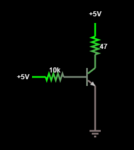jFoster
Newbie level 5
- Joined
- Aug 3, 2016
- Messages
- 8
- Helped
- 0
- Reputation
- 0
- Reaction score
- 0
- Trophy points
- 1
- Location
- British Columbia, Canada
- Activity points
- 86
Hi,
I'm trying to understand the fundamentals of transistors but I'm having a hard time with getting my circuit to work the way I want in real life.
My circuit is a basic common emitter configuration (I think):

The beta value of the transistor is 150, so I calculated the current through the collector resistor in theory and it should be about 63mA. I confirmed it by running it in a simulator and the results were the same.
In real life, I get a current of about 53mA. I thought that was pretty strange and after doing some more experimenting I removed the collector resistor entirely and saw that the collector current rose to 63mA. Now I know the 47ohm resistor at 5V should pass about 106mA so I can't understand why the current is less when the resistor value is added. I removed the resistor value in the simulator and I got the same 63mA collector current (it didn't increase at all).
It's probably something really simple, but any help would be much appreciated!
Thanks,
Judd
I'm trying to understand the fundamentals of transistors but I'm having a hard time with getting my circuit to work the way I want in real life.
My circuit is a basic common emitter configuration (I think):

The beta value of the transistor is 150, so I calculated the current through the collector resistor in theory and it should be about 63mA. I confirmed it by running it in a simulator and the results were the same.
In real life, I get a current of about 53mA. I thought that was pretty strange and after doing some more experimenting I removed the collector resistor entirely and saw that the collector current rose to 63mA. Now I know the 47ohm resistor at 5V should pass about 106mA so I can't understand why the current is less when the resistor value is added. I removed the resistor value in the simulator and I got the same 63mA collector current (it didn't increase at all).
It's probably something really simple, but any help would be much appreciated!
Thanks,
Judd
